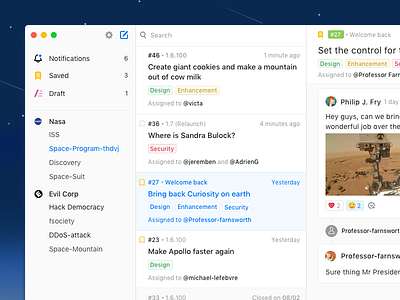- Github App For Macos Windows 10
- Github App For Macos High Sierra
- Github App For Macos 10.13
- Github App For Macos Catalina
- Github App For Mac
What is macFUSE?
GitHub Desktop allows developers to synchronize branches, clone repositories, and more. Pull requests, merge button, fork queue, issues, pages, wiki: all awesome features that make sharing easier. But those things are only great after you've pushed your code to GitHub. How to Show & Verify Code Signatures for Apps in Mac OS X - How to Show & Verify Code Signatures for Apps in Mac OS X. Ensure the name of the VM is MacOS (ensure to keep the same casing) Ensure the type is Mac OS X and the version is macOS 10.12 Sierra (64-bit) (there is a High Sierra option too, but I chose Sierra by accident and it worked) Untick Floppy in System Motherboard Boot Order; Use = 4096 MB of memory in System Motherboard. Cli/cli GitHub’s official command line tool GitHub CLI gh is GitHub on the command line. It brings pull requests, issues, and other GitHub concepts to the terminal next to where you are already working with git and your code. Fusion GitHub Org theme. Run, Build or Test any app, anywhere, any time. With support for building and running Containers, Kubernetes and Virtual Machines side-by-side, Fusion can help you build new cloud services or modernize existing apps.

macFUSE allows you to extend macOS's native file handling capabilities via third-party file systems.
Features
As a user, installing the macFUSE software package will let you use any third-party FUSE file system. Legacy MacFUSE file systems are supported through the optional MacFUSE compatibility layer.
As a developer, you can use the FUSE SDK to write numerous types of new file systems as regular user space programs. The content of these file systems can come from anywhere: from the local disk, from across the network, from memory, or any other combination of sources. Writing a file system using FUSE is orders of magnitude easier and quicker than the traditional approach of writing in-kernel file systems. Since FUSE file systems are regular applications (as opposed to kernel extensions), you have just as much flexibility and choice in programming tools, debuggers, and libraries as you have if you were developing standard macOS applications.
How It Works
In more technical terms, FUSE implements a mechanism that makes it possible to implement a fully functional file system in a user-space program on macOS. It provides multiple APIs, one of which is a superset of the FUSE API (file system in user space) that originated on Linux. Therefore, many existing FUSE file systems become readily usable on macOS.
The macFUSE software consists of a kernel extension and various user space libraries and tools. It comes with C-based and Objective-C-based SDKs. If you prefer another language (say, Python or Java), you should be able to create file systems in those languages after you install the relevant language bindings yourself.
The filesystems repository contains source code for several exciting and useful file systems for you to browse, compile, and build upon, such as sshfs, procfs, AccessibilityFS, GrabFS, LoopbackFS, SpotlightFS, and YouTubeFS.
About
Jumpcut is a macOS clipboard manager that provides Mac users with quick, intuitive access to their clipboard history, with an interface that stays out of their way. It’s been around for over fifteen years, saving users time and preventing frustration whenever they need to use a phone number, URL, or code snippet that they had just a minute ago. It’s absolutely free and open source under the MIT License.
The most recent version of Jumpcut is 0.73, released October 2020.
or install using Homebrew:
Jumpcut currently supports versions of macOS from 10.11 (El Capitan) forward. Users of older Macintoshes may want to consider Jumpcut 0.63, which supports operating systems as old as OS X 10.3.9 Panther.
Github App For Macos Windows 10
Code is available on GitHub. Jumpcut is written in Objective-C.
Github App For Macos High Sierra
Note to Upgraders
Users upgrading from 0.63 have reported issues with the Accessibility tab of the “Security & Preferences” Preferences panel, which is required to make the paste functionality work. If Jumpcut is not pasting despite the “Clipping selection pastes” preference being checked in Jumpcut, please see here.
Using Jumpcut

Jumpcut is designed to be simple. Move the Jumpcut application (the one with the pretty scissors icon) to your Applications directory. Launch Jumpcut. A scissors icon will appear in your menu bar. Now whenever you cut or copy a text item, it’ll be added to the “stack” of clippings that Jumpcut has recorded.
To get at a clipping, choose one from under the Jumpcut menu item. Or, set a global hotkey (from the Preferences menu) and begin using Jumpcut via keyboard. (The default value for this hotkey is Command + Option + V.) Typing it will bring up a pop-up bezel, similiar to the application switcher. Hold the modifier keys (Command and Option by default) and use the arrow keys or the non-modifier key (V, by default) to scroll through the stack. (Shift plus the non-modifier key scrolls in reverse. Release all keys to select the clipping, or hit Escape to cancel.
When you’ve selected a clipping, Jumpcut will put it on the pasteboard and attempt to paste it into your application. It does this by mimicking a user typing Command-V. (As such, the first time you run Jumpcut, you’ll be prompted by macOS to give Jumpcut access to type into other programs. If this access is not given or the “Clipping selection pastes” in preference in Jumpcut is unchecked, the clipping will still be put on your pasteboard and you can paste manually. (If you change your mind, you can add Jumpcut in the Accessibility pane of the “Security & Privacy” System Preference manually.) Read more about accessibilty.
Jumpcut remembers the last clipping you selected using the bezel. The next time you bring the bezel up, it will start with that clipping unless it’s scrolled off the stack.
Additional Behavior
Some users may prefer to use a 'sticky bezel'; if this preference is enabled, you must hit return to select a clipping or escape to dismiss the bezel once it is activated.
Github App For Macos 10.13
Not Using Jumpcut
Not for you? You might want to try out other open source macOS clipboard managers, such as Maccy or Clipy.
Contributing to Jumpcut
Github App For Macos Catalina
I review pull requests and issues filed and welcome questions or suggestions, but Jumpcut is a hobbyist project and releases should be expected to be infrequent.
Miscellania
Github App For Mac
A “jump cut” is a film editing technique in which two shots of the same subject matter from slightly different angles are shown sequentially, creating an effect of jumping forward in time. Jumpcut is designed to move your clipboard backward in time, but it’s a nice name for a lightweight clipboard manager, and I like both Breathless and Man with a Movie Camera.
My contact info is available on GitHub.
Fork me on GitHub